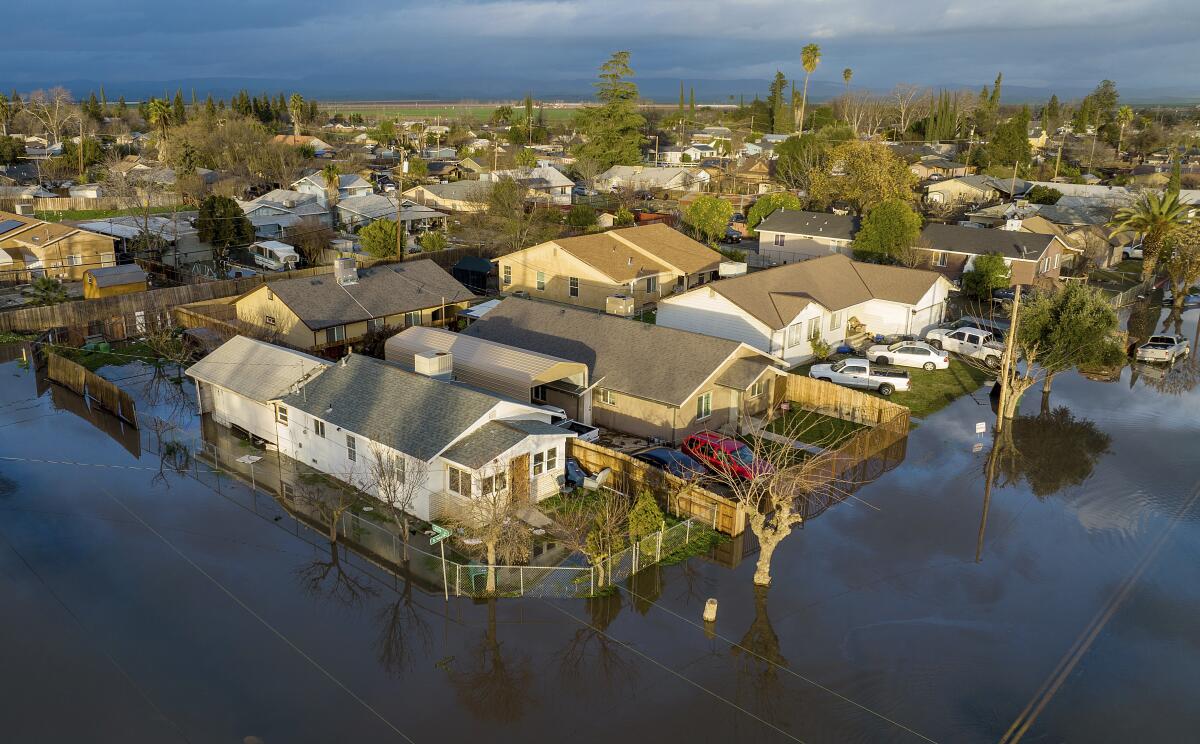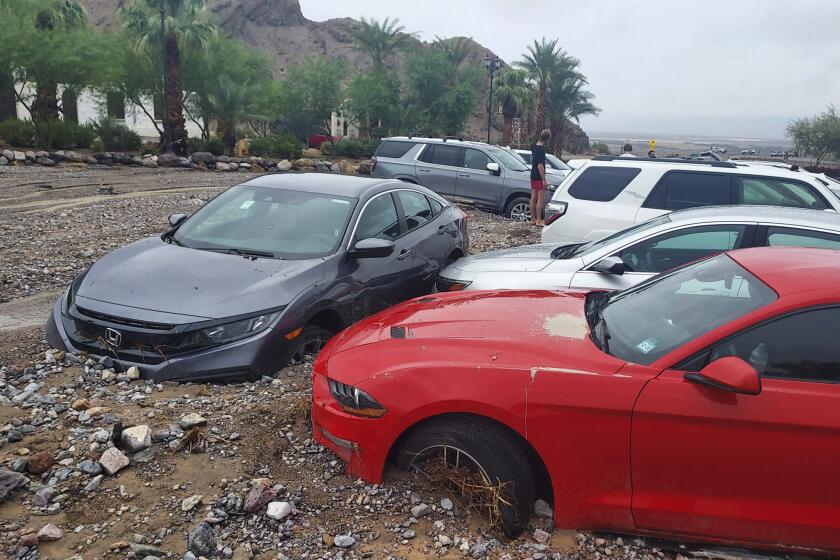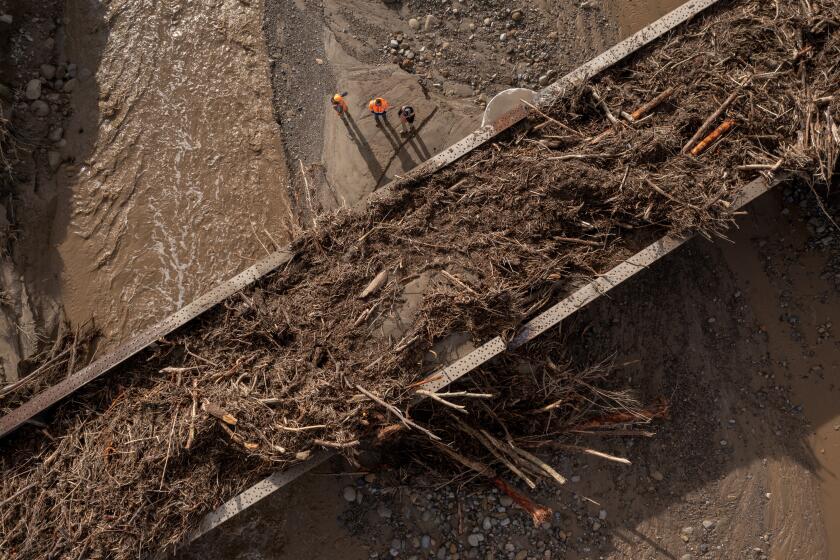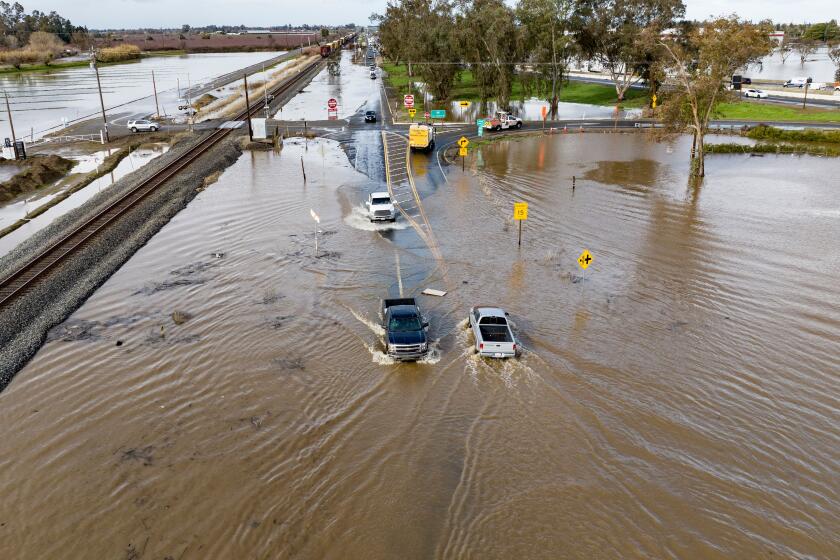California faces catastrophic flood dangers — and a need to invest billions in protection

- Share via
The storms that have been battering California offer a glimpse of the catastrophic floods that scientists warn will come in the future and that the state is unprepared to endure.
Giant floods like those that inundated the Central Valley in 1861 and 1862 are part of California’s natural cycle, but the latest science shows that the coming megafloods, intensified by climate change, will be much bigger and more destructive than anything the state or the country has ever seen.
A new state flood protection plan for the Central Valley presents a stark picture of the dangers. It says catastrophic flooding would threaten millions of Californians, putting many areas underwater and causing death and destruction on an unprecedented scale. The damage could total as much as $1 trillion.
The plan, approved last month, calls for $25 billion to $30 billion in investments over the next 30 years in the Central Valley, and outlines recommendations that include strengthening levees and restoring natural floodplains along rivers.
Despite worsening drought conditions, global warming has already doubled the odds that California will experience a catastrophic ‘megaflood.’
Flood protection efforts have been underfunded in California for years, and the plan says much more investment is urgently needed from state, federal and local agencies.
“We need to invest in what is necessary to improve life safety, protect vital infrastructure and improve our environment,” said Jane Dolan, president of the Central Valley Flood Protection Board. “The time to act is now.”
The plan calls for spending $3.2 billion on flood protection projects in the valley over the next five years, with the largest portion of the funding from the state.
“We know we need twice to three times what’s being spent now,” Dolan said.
The plan — the state’s latest five-year update of a blueprint first adopted in 2012 — describes how global warming will push the average snow elevation higher in California’s mountains, where more precipitation will fall as rain. Scientists have also warned that large atmospheric rivers are set to become stronger, unleashing more intense flooding as they roll in from the Pacific.
“By 2072, climate change is predicted to increase peak flood flows up to five times in the Central Valley compared to past recorded events,” the plan says. “At risk are millions of people and billions of dollars of critical infrastructure, commerce, agriculture and the environment.”
The powerful storm that knocked out power, toppled trees — including one that killed a toddler — and flooded homes along the coast in Santa Cruz continued its march through the region.
Catastrophic floods would be devastating not only for California but also for the nation’s economy, the report says, and the risks will continue growing.
“Climate change is accelerating this risk faster than we have been able to address it,” the report says.
The 298-page document says that if the state doesn’t make investments to address the dangers, major floods could cause, on average, more than 500 deaths annually in the Central Valley by 2072. Officials calculated that a substantial number of lives would be saved, and damage reduced, if adequate investments are made in infrastructure and other projects.
The state’s plan focuses partly on projects that would restore natural floodplains to give floodwater room to spread out and dissipate. Doing so could ease flood risks while also helping to replenish groundwater, which has been depleted by agricultural pumping.
“Having floodwaters spread out can be beneficial to groundwater supply, along with saving lives and infrastructure,” Dolan said. “The levees are going to fail at some point, will be overtopped when there’s intense storms. So we need to make more room.”
The rural town is among numerous communities hit hard by days of relentless rain and flooding from the California storms.
Other issues that need to be addressed include aging levees, a backlog of deferred maintenance work on flood-control infrastructure and the expansion of development in flood-prone areas.
“In some areas, we will need to raise a levee. And yet in others, we will need to expand and then create some kind of a setback in the levee system in order to give the river the room to breathe and to meander,” said Chris Elias, executive director of the San Joaquin Area Flood Control Agency. What’s needed in many areas, he said, is a “relief valve” to let flooding rivers spread out on the landscape, where the water can slow down and percolate into the ground.
One part of the Central Valley that faces substantial risks is the Stockton area, where local flood protection projects have been underfunded, Elias said.
With climate projections showing how much larger flows could come raging down the San Joaquin River, the existing levees are undersized, Elias said. “We need to really work hard to make some improvements, to take a look at those levees, rework them to be able to handle the increases in flows,” he said.
Next to Stockton, large residential developments have been built in recent years in the low-lying communities of Manteca and Lathrop. To address such risks, the plan lays out priority projects from upgrading levees to expanding a bypass called Paradise Cut, which is intended to relieve pressure on the levees.
Restoring more of the valley’s natural floodplains can also nourish ecosystems and help struggling populations of fish and other wildlife. State officials say that would bring big environmental benefits because most of the valley’s wetlands and riparian habitats have been drained and destroyed, with only about 5% remaining.
Dolan said the Central Valley needs to identify appropriate areas for widening floodplains. She said that will mean replicating efforts like the Dos Rios Ranch Preserve, the state’s largest floodplain restoration project, located at the confluence of the San Joaquin and Tuolumne rivers. The nonprofit group River Partners restored the floodplain by removing berms that farmers had built, opening the way for water to seasonally flood about 1,000 acres.
“When you can spread water out across the landscape safely upstream of a neighborhood or a residential area, you can hopefully convey that water more safely through,” said Julie Rentner, president of River Partners.
The new flood plan is a “broadly supported road map” for addressing flood hazards in the valley, Rentner said, but one that still needs political will and a lot more investment.
“It’s just staggering when you really look at how destructive a big flood would be,” Rentner said. “We only have a short amount of time, a decade or two, to get underway with the big solutions that we think are going to work.”
Scientists have studied catastrophic scenarios, examining the 1861-62 floods that left Sacramento underwater as well as larger floods that occurred centuries ago. In 2011, researchers released an analysis of a scenario they called ARkStorm, named for Atmospheric River 1,000 Storm, in which a series of powerful atmospheric river storms would leave large portions of the Central Valley and the Los Angeles Basin underwater.
In a study last year, scientists Xingying Huang and Daniel Swain found that climate change is dramatically increasing the risk of a catastrophic megaflood in California. Their research showed climate change has already doubled the likelihood of a once-in-a-century flood in any given year.
They projected that by the latter part of the century, an extreme series of storms will likely bring 200% to 400% more runoff in the Sierra Nevada because of increased precipitation, and because more of that precipitation will come as rain rather than snow.
Swain, a climate scientist at UCLA, said the new flood protection plan for the Central Valley represents a positive step for the state to become more prepared.
“I think that California would be in a better place from a flood risk perspective if the entire plan were fully implemented, and funded,” Swain said.
However, he said, the state still needs to do flood modeling for ARkStorm scenarios based on the latest science. Swain said that will happen this year with funding from the state Department of Water Resources and a high-resolution flood model used by the Oak Ridge National Laboratory.
“What we’re going to do is essentially run these ARkStorm scenarios as if they were real events and say, OK, who gets flooded? How deeply? For how long?” Swain said. “And hopefully, we’ll be able to get a much more comprehensive answer to just what the actual floods would look like during one of these kinds of plausible, either present or future era, megastorms. It’s going to be ugly.”
Such a flood could leave many areas underwater, displacing millions of Californians and causing untold loss of life. Highways and evacuation routes could be cut off, and low-lying airports could be flooded. The monumental damage inflicted could hobble much of the state for months or longer.
When the catastrophic floods come, whether it turns out to be 10 years or 30 years from now, Swain said: “I don’t want to be reflecting in retrospect that we really could have prepared for it and didn’t. Because at this point, I think the warning signs are pretty clear.”
Deirdre Des Jardins, an independent water researcher and advocate, said modeling where floodwaters will go is urgently needed. She said she is very concerned that the state is seriously unprepared.
“We’re continuing to build in floodplains through various loopholes. And so we have this expanding bull’s-eye,” Des Jardins said. “We should not be building housing in Stockton until there is adequate flood protection. There’s just pressure from developers to look the other way, and I fear it will not end well.”










